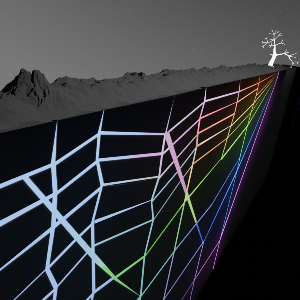Heat flows the secret to order in prebiotic molecular kitchen
4 Apr 2024
LMU biophysicists have demonstrated how heat flows through rock fissures could have created the conditions for the emergence of life.
4 Apr 2024
LMU biophysicists have demonstrated how heat flows through rock fissures could have created the conditions for the emergence of life.

Schematic visualization of heat flows in rock cracks. | © Christof Mast
Life is complicated. What is true for our everyday existence also holds for the many complex processes that take place inside cells. Proteins constantly have to be synthesized, cell walls built, and DNA replicated. This can only work when reaction partners converge at the right time in sufficiently high concentrations while suffering little disruption from other substances. Over the course of billions of years, evolution has perfected these mechanisms and ensured that such vital processes occur with high efficiency at the correct place.
Circumstances were probably a lot more chaotic four billion years ago, when prebiotic reactions created the conditions for the emergence of the first lifeforms. For these reactions, too, it was necessary for the ‘right’ substances to be brought together at the ‘right’ time in one place, so that more complex biomolecules like RNA and amino acid chains could form. While such reactions are possible to recreate in the laboratory thanks to manual intermediate steps, it is highly challenging for them to come about in a simple ‘primordial soup’ – that is to say, a very dilute mixture of prebiotic building blocks. So how could nature create suitable conditions for the origin of life?
Our investigations show how simple heat flows could have yielded order amid the chemical chaos of primordial times and fostered the first prebiotic reactions.Christof Mast
A collaboration of LMU biophysicists Dr. Christof Mast and Professor Dieter Braun, coordinator at the ORIGINS Excellence Cluster, and geoscience Professor Bettina Scheu have found a possible answer to this question and recently published their results in the journal Nature. “Our investigations show how simple heat flows could have yielded order amid the chemical chaos of primordial times and fostered the first prebiotic reactions,” explains Mast. Heat is produced by a wide range of geological and chemical processes, so presumably heat flows occurred almost everywhere in those distant times. If this heat flows through thin, water-filled cracks, such as arise through the rapid cooling of molten rock, it leads to water convection and to a directed movement of the dissolved molecules in the water along the heat flow. Combined, these two effects – convection and thermophoresis – drive accumulation and selective up-concentration of the various solutes in different places.
Mast’s group has now experimentally demonstrated this selective accumulation for over 60 different prebiotic building blocks, such as nucleobases and amino acids. They found that these substances can differ strongly in their thermophoresis and therefore enrich differently in the rock fissures. “In a system of interconnected cracks and fissures in the rock, this effect is reinforced and produces mixtures with different compositions of prebiotic substances in each fissure,” explains Thomas Matreux, lead author of the paper. “Although the initial solution was uniformly dilute, and therefore unreactive, simple heat flows can generate an astonishing variety of possible starting conditions for prebiotic chemistry in this manner,” adds Paula Aikkila, the other lead author of the study.
Without the aid of modern lab technology or the advanced reaction mechanisms of life today, nature could thus have created a ‘molecular kitchen’ in large geological network systems, in which all the ingredients of life were sorted and ready. As part of the Collaborative Research Centre “Molecular Evolution in Prebiotic Environments” (CRC 392), the researchers now plan to investigate how many ‘dishes’ of life can be ‘prepared’ in this system.
Thomas Matreux, Paula Aikkila, Bettina Scheu, Dieter Braun & Christof B. Mast: Heat flows enrich prebiotic building blocks and enhance their reactivity. Nature 2024